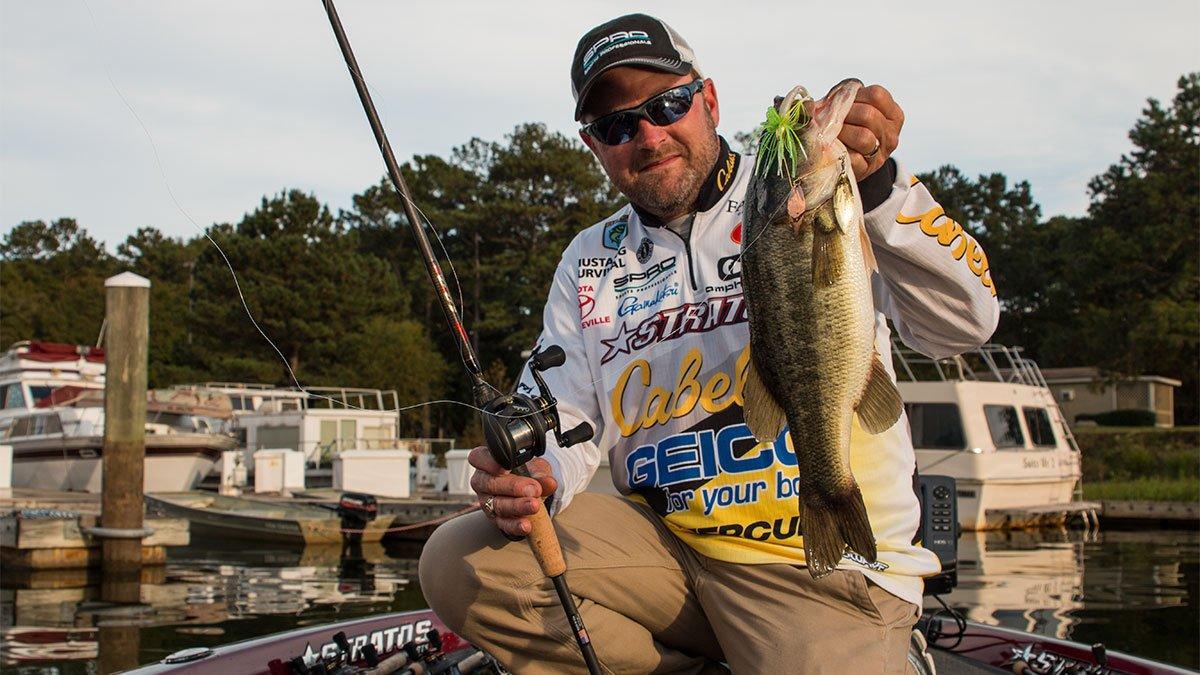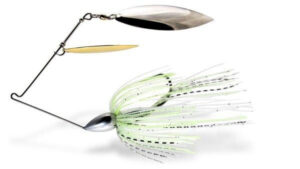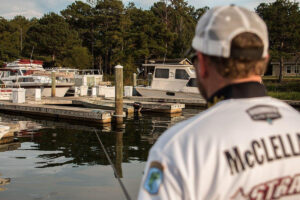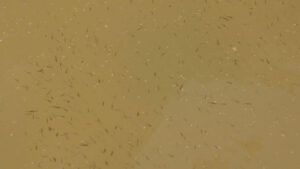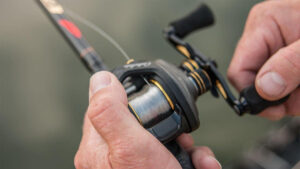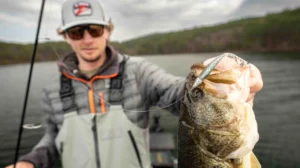Over the past half-decade or so, spinnerbaits have ominously fallen out of favor with many anglers. With the recent influx of new and innovative bass fishing lures, this traditional favorite is slowly being nudged to the proverbial backburner of our tackle collections. But be warned; this trend may very well be costing us countless fish catches throughout the spring months.
Elite Series pro Mike McClelland is a steadfast believer in the effectiveness of spinnerbaits. In fact, he believes these lures to be among the most effective imaginable when targeting boat docks during all three stages of the spring spawning period. When the water temperatures reach the 50 to 55-degree range, be ready for some of the best spinnerbait action of the entire year.
Arbitrarily casting these lures to boat docks, however, doesn’t always cut it. In order to maximize both your effectiveness and efficiency, there are a number of critical aspects to consider.
Embrace the darkhorse
You can certainly enjoy success using today’s more trendy lure categories throughout the entire spawning period, but let’s not forget the importance of familiarity. McClelland believes bass become quickly accustomed to what he calls the “springtime norms” such as swimbaits and squarebill crankbaits.
“Big female bass are not as dumb as we’d like to think,” McClelland said. “After seeing hundreds, if not thousands, of the same ol’ lures each weekend, I’m convinced they’re becoming conditioned to them. That’s why, in my opinion, spinnerbaits are so incredibly effective in the spring. The fish rarely see them anymore, so they’re more apt to mistake them as natural forage.”
According to McClelland, there are two primary reasons why spinnerbaits are often overlooked. Understanding these factors is important to becoming a more well-rounded blade angler.
- Aging lakes— Nothing, including our favorite fisheries, can escape Father Time. While many of the nation’s lakes were full of textbook bass-holding cover 15 to 20 years ago, decades of constant water fluctuation, hurricanes and tornadoes have diminished this cover in a significant manner. Because spinnerbaits are most often used in and around thick cover, the natural aging of these lakes has reduced the perceived value of them.
- The emergence of the bladed swim jig— You’re probably familiar with them. Heck, we even write about them throughout the year. Although bladed swim jigs are popular fish-catchers, one could argue that they’ve improved the spinnerbait bite nationwide. Remember the familiarity issue we discussed? It certainly applies in this situation. With more anglers opting for the “latest” and “greatest”, a well-placed spinnerbait is now a tempting—and unfamiliar—offering to big bass.
Versatility and vibration
With all of the theories and postulation out of the way, let’s get down to the very essence of spring spinnerbait fishing. We’ll first refer to a popular cliché we’ve all heard since grade school.
“April showers bring May flowers.”
The first two words of that phrase are critical in terms of spinnerbait fishing. The early spring is notorious for being a season filled with heavy precipitation events, which results in stained waters in many of our local fisheries. The resulting decrease in visibility forces bass to rely more heavily on their lateral lines, making spinnerbaits incredibly difficult to beat.
“With the right blade combination, a spinnerbait can produce a tremendous amount of vibration which is a major deal in dingy water,” McClelland said. “Big Indiana or Colorado blades thump throughout the entire retrieve, which allows the bass to track them down and attack them easily.”
In addition to their intense vibration, these lures are also extremely versatile for several reasons.
- Cover the water column— “You can fish a spinnerbait in any depth imaginable,” McClelland said. “One of the most important aspects of springtime dock fishing is determining whether the bass are on the dock, suspended on shade lines or hugging the bottom. This bait allows you to cover all of your bases without constantly retying.”
- More than shad imitators— Contrary to popular belief, spinnerbaits can imitate much more than shad. In recent years, McClelland has experimented with brown, green and even red skirts with outstanding success. Such colors can easily mimic a guppy, perch, crawfish and bluegill—all of which are major food sources for spring bass.
Boat docks are a one-stop shop
If you were placed on a totally unfamiliar lake with one hour to catch a bass, where would you start? If you’d begin by dissecting any boat docks in the immediate vicinity, you’re not alone. It’s engrained in an fisherman’s DNA—docks hold bass. But why?
- Feeding— Bass are largely ambush feeders, meaning they’ll often tuck themselves into cover, with their nose facing open water, in order to attack unsuspecting prey as it passes by. Boat docks just so happen to offer countless ambush points for feeding bass. Whether it’s posts, ladders, floats or even the shadows cast by the platform, these manmade platforms are absolute bass magnets.
- Rest— Bass don’t roam around all day looking for a meal. In fact, there have been several studies that have revealed very small feeding periods throughout the day. When the bass aren’t on a major feed, they prefer somewhere dark and quiet while resting. Again, docks fit the bill perfectly. They can hang out in the perceived safety of the dock shadows and, essentially, recharge their batteries until the next feeding period.
- Staging— As bass make their way toward spawning pockets each spring, they’ll use docks in the same manner as humans use rest stops on the interstate, which is commonly referred to as “staging”. They’ll often stop first on deep docks near primary points, close to their wintering locations. As the water temperatures warm, they’ll slowly progress to secondary point docks and finally to shallow spawning docks when the water temperatures near 60 degrees. After their spawning rituals are complete, they’ll follow this same route in reverse order as they make their way to their deepwater summertime haunts.
Stage No. 1: Prespawn docks
The prespawn period is one of the best times to catch a trophy bass. They’ve just endured a long winter, they’re at their heaviest, they’re hungry and their biological clocks are screaming at them to begin their annual shallow-water migration. If you’re able to identify the “right” docks, you’ll have a remarkable chance of catching a giant.
- What to look for— “When I’m looking for prespawn docks, I want floating docks to be situated on a 45-degree bank adjacent to some sort of creek channel bend,” McClelland said. “If I’m on a lake with wooden pier docks, I’m looking for the docks that have the deepest water nearby. In either situation, concentrate on secondary points because these are very natural stopping places for prespawn females. And as with any dock, some nearby brush never hurts anything.”
- Spinnerbait selection— If McClelland notices stained water conditions, he’ll opt for a Colorado-Indiana blade combination or a turtle back combination to increase the spinnerbait’s vibration factor. In river systems, he’s had his best success using a smaller 5/16-ounce War Eagle Turtle Back Spinnerbait while a larger 1/2 to 3/4-ounce Colorado-Indiana War Eagle Spinnerbait tends to shine in bigger fisheries
- Cold, muddy water—In especially muddy water in the 45 to 50-degree temperature range, McClelland prefers white blades on his spinnerbait. Not only does it increase visibility, but it also mimics the pale coloration of late-winter bass forage.
- Retrieve— “The biggest key in the prespawn is keeping your spinnerbait on the bottom,” McClelland said. “When you feel it try to hang up on something, that’s when you give it a little twitch to entice a reaction strike. If you can’t feel the lure bumping the bottom, you’re reeling way too fast.”
Stage No. 2: Spawning docks
When most anglers think of spawning bass, visions of soft plastic baits and topwater lures flood their minds. While these are certainly viable options, spinnerbaits are incredible locator tools when you’re targeting bedding fish in muddy water. Even if you’re not able to catch the bass, it allows you to cover water quickly and trick bass into protectively “snapping” at the bait which gives up their exact location.
- What to look for— “Docks are great places to find spawning bass,” McClelland said. “But you need to make sure you’re fishing docks that are on flat banks with a hard bottom composition such as gravel, sand or shell. These are easy targets for spawners because they often position themselves against something while they spawn. The corners of docks are most effective because they’re not in the shade—the bass eggs need sunlight penetration to survive.”
- Spinnerbait selection— McClelland most often utilizes a 1/2 to 3/4-ounce double willow leaf War Eagle Spinnerbait when fishing docks during the spawn. If it’s cloudy, his larger blade will be gold with a nickel top blade. On sunny days, however, he reverses his blade collection.
- Retrieve— “Sudden stops of your retrieve tend to result in some really great strikes this time of year,” McClelland said. “Essentially, you’re winding the bait back to the boat and killing it on top of likely bedding areas. So if I’m casting towards a dock, I’m going to stop my retrieve at each outside corner post of the dock, because this is where bass are notorious for spawning.”
Stage No. 3: Post-spawn docks
When the shallow-water romance of the spawn subsides, the bass fishing can become a bit tricky, to say the least. The male, or “buck” bass hang back and guard newly hatched bass, or “fry” while the females recharge and try to enjoy a little alone time. This obstinate behavior, however, is remedied by late-spring shad spawns and spinnerbaits become an even bigger player.
- What to look for— “The best docks during the post-spawn can vary,” McClelland said. “They’ll stay around flatter docks for a little bit, but they’ll soon start pushing their fry towards docks closer to deep water. That’s why I love fishing marina docks during this period. Lots of bass will spawn in marinas and use the adjacent deep water to guard their fry into the post-spawn. You’ll also have some awesome shad spawns around the floats of marina docks, which is some of the most fun you can possibly have.”
- Spinnerbait selection— McClelland tends to stick with his 1/2 or 3/4-ounce double willow leaf spinnerbait throughout much of the post-spawn. To maximize his retrieve speed and the flash of his lure, he most often uses nickel blades.
- Retrieve—“Speed is the name of the game throughout the post-spawn,” McClelland said. “I’ll wind my spinnerbait super-fast and look for purely reaction bites. It’s an awesome way to tick off a fry guarder. I try to make the blades of my spinnerbait throw a ripper right underneath the surface and I’ll even incorporate sudden jerks to make a big boil. That boil simulates another fish feeding on something, which triggers their competitive instinct.”
McClelland’s spinnerbait setup
Using proper gear can make your life a lot easier when targeting springtime docks with spinnerbaits. You might be able to get away with wimpy gear for a few fish catches, but you’re likely setting yourself up for a potential heartbreak.
With that being said, power is a major factor when McClelland rigs up for a day of spinnerbait fishing.
- Line— “Line type is absolutely critical when you’re throwing a blade,” McClelland said. “Most of the time I’m going to use 20 to 25-pound Sunline Reaction FC Fluorocarbon because it has a little more stretch than traditional fluoro but plenty of sensitivity. I’m basically trying to use the heaviest line I can get away with, so very seldom do I use less than 16-pound test. A heavy monofilament is also an option, such as 20-pound Sunline Supernatural Monofilament.”
- Reel— When conditions call for slow-rolling his spinnerbait, McClelland uses a 5.1:1 Cabela’s Verano Casting Reel in order to “make” himself slow down. As the post-spawn period approaches and speed begins to play a big role, he’ll switch to a 7.1:1 Verano Casting Reel or even a 8.1:1 Cabela’s Arachnid Casting Reel.
- Rod— “Anytime I’m throwing a spinnerbait that’s 1/2-ounce or lighter, I like to use the Falcon MMC 5172 Casting Rod,” McClelland said. “But when I upsize to a big 3/4-ounce blade, I’m going to use a stouter rod, such as the Falcon MMC 6174 Casting Rod.”
If you’ve fallen out of love with your spinnerbait collection in recent years, don’t be afraid to dust ‘em off this spring. When you combine strategically placed docks with the flash and vibration of a spinnerbait, some amazing things can happen.


